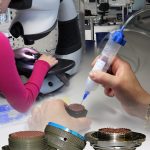Unfortunately, and as much as some would like you to believe, standard parts are generally not of a high enough performance or quality to be suitable for use in harsh environments, such as defence, aerospace and space applications. Extremes of shock, vibration and temperature, extended life cycles, possible attack by gases and liquids require components that have been designed to work under specific and often very demanding conditions. Not only that, but they must be ultra-reliable…often such applications simply must not fail, either because failure would risk life, or the cost of failure would be astronomical (sometimes literally!).
The most widely specified and used standard governing such ‘high-performance’ parts is the US defence standard known as MIL -STD. A huge variety of electronic components – active, passive, emech, interconnect, hybrid and even sub-systems – are covered by various different MIL-STDs which govern the manufacture and testing of the parts in question.
All well and good, but there is a problem. MIL-STD numbers are associated with a specific component. Developing MIL-STDs for new parts is a long process, and once the standard is developed, for a component manufacturer to get that part listed is a long a costly process.
What this means is that engineers working on designs that require high performance, high reliability components will be limited to older technology components, as new smaller, lighter, faster – maybe even cheaper – parts will not yet have had a MIL-STD created for them, or of it has, the manufacturer may not yet have received approval.
Luckily a couple of alternatives are emerging.
- Standard parts are generally not of a high enough performance or quality to be suitable for use in harsh environments, such as defence, aerospace and space applications
- TTI, Inc. offers MIL-DTL-38999 QPL connector assembly service from its European facility in Munich
COTS+
Many engineers will have heard the term COTS – Commercial Off-The-Shelf. In the USA, COTS is a Federal Acquisition Regulation (FAR) term for commercially-available items and services that can be bought and used under government contract. It has come to be a widely used term, and the concept appears especially appealing in the light of defence budget cuts and restrictions. However, to put it plainly, components designed for use in the commercial world are often unsuitable for the rigours of military, space and aerospace applications.
COTS+ is a development from COTS which can address the disparity between the requirement for a lower cost, more easily available device and one which is fully-approved to meet harsh environment use. COTS+ programs start with an enhanced part – often an automotive grade device that may have, say, an elevated operational temperature range – then add specific tests as necessary for an application.
All COTS+ programs vary and some have different names. An example is KEMET’s ‘COTS program’ – which we would describe as COTS +. KEMET regularly supplies ‘up-screened’ products by working with customer drawings and imposing specified design and test requirements. Their COTS program offers the same high quality and high reliability components as up-screened products, but at a lower cost to the customer. This is accomplished by eliminating the need for customer-specific drawings to achieve the reliability level required for customer applications. A series of tests and inspections have been selected to provide the accelerated conditioning and 100% screening necessary to eliminate infant mortal failures from the population.
KEMET’s C0G dielectric features a 125°C maximum operating temperature and is considered ‘stable.’ The Electronics Components, Assemblies & Materials Association (EIA) characterizes C0G dielectric as a Class I material. Components of this classification are temperature compensating and are suited for resonant circuit applications or those where Q and stability of capacitance characteristics are required. C0G exhibits no change in capacitance with respect to time and voltage and boasts a negligible change in capacitance with reference to ambient temperature. Capacitance change is limited to ±30 ppm/°C from -55°C to +125°C.
KEMET’s COTS testing includes voltage conditioning and post-electrical testing as per MIL–PRF–55681. For enhanced reliability, KEMET also provides the following test level options and conformance certifications (see Figure 1):
A: Testing per MIL–PRF–55681 PDA 8%
B: Testing per MIL–PRF–55681 PDA 8%, DPA per EIA–469
C: Testing per MIL–PRF–55681 PDA 8%, DPA per EIA–469, Humidity per MIL–STD–202, Method 103, Condition A
Various other manufacturers have COTS+ programs including Amphenol, AVX, Harwin, Honeywell, Souriau, TE, TT and Vishay.

Lee Thompson, Director Industry Marketing, Europe, Defence, Aerospace & Space for TTI.
DSCC
Defense Supply Center, Columbus (DSCC) qualification is another way to address the issue of needing to use approved parts that are latest generation technology offerings. In many ways it is very similar to MIL-STD, including being administrated from the same United States Department of Defense, Defense Logistics Agency (DLA) site (Columbus, Ohio).
Even more than that, DSCC approvals very often reference MIL-STDs for testing and procedure. Where they differ is that they are much more flexible and quicker to implement. It is, for example, much quicker to bring on a DSCC standard for an increased capacitor voltage range – ie from 50V to 100V – than it would be under the MIL-STD scheme. So designers get to work with the latest technologies rather than having to wait for the standards to catch up.
Currently there are DSCC approval covering passive and semiconductor parts, and it looks likely that it will migrate to cover electromech and connectors shortly.
TTI works with a number of suppliers that offer parts for high reliability applications. We urge designers to look beyond the limitations of the MIL-STD portfolio to see whether a COTS+ device or a component carrying DSCC approval might not offer the performance they need.









